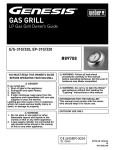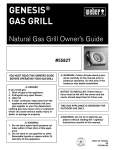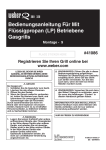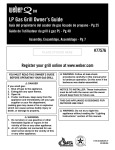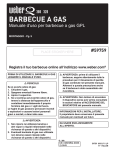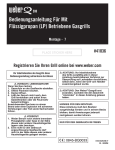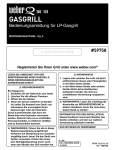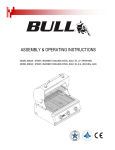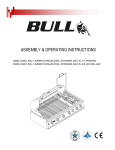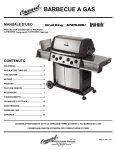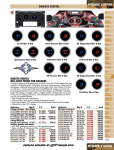Download Weber 41081 Owner`s manual
Transcript
LP Gas Grill Owner’s Guide Assembly - Pg 9 PLACE STICKER HERE #41081 Register your grill online at www.weber.com YOU MUST READ THIS OWNER’S GUIDE BEFORE OPERATING YOUR GAS GRILL DANGER If you smell gas: 1. Shut off gas to the appliance. 2. Extinguish any open flames. 3. Open lid. 4. If odour continues, keep away from the appliance and immediately call your gas supplier or your fire service. Leaking gas may cause a fire or explosion, which can cause serious bodily injury or death, or damage to property. WARNING WARNING: Follow all leak-check procedures carefully in this manual before operating barbecue. Do this even if barbecue was dealer assembled. WARNING: Do not try to light the Weber® gas barbecue without first reading the “Lighting” instructions in this manual. INFORMATION FOR THE INSTALLER: This manual must remain with the owner, who should keep it for future use. OUTDOOR USE ONLY. 1. Do not store or use petrol or other flammable vapours and liquids in the vicinity of this or any other appliance. 2. A gas supply cylinder not connected for use should not be stored in the vicinity of this or any other appliance. 0845BQ-0033 0845 41081 11/16/07 LP GB - ENGLISH 2 DANGERS AND WARNINGS DANGER Failure to follow the Dangers, Warnings and Cautions contained in this Owner’s Manual may result in serious bodily injury or death, or in a fire or an explosion causing damage to property. WARNINGS Follow regulator connection instructions for your type of gas grill. Do not store a spare or disconnected gas supply cylinder under or near this barbecue. Do not put a barbecue cover or anything flammable on or in the storage area under the barbecue. Improper assembly may be dangerous. Please carefully follow the assembly instructions in this manual. After a period of storage and/or non-use, the Weber Gas Barbecue should be checked for gas leaks and burner obstructions before use. See instructions in this manual for correct procedures. Do not use a flame to check for gas leaks. Do not operate your Weber® gas barbecue if there are any leaking gas connections. Flammable materials should not be present within approximately 60 cm of the back or sides of the barbecue. Your Weber® gas barbecue should not be used by children. Accessible parts of the barbecue may be very hot. Keep young children away while it is in use. Exercise caution when using your Weber® gas barbecue. It will be hot during cooking or cleaning, and should never be left unattended, or moved while in operation. If the burners should go out during cooking, turn off all gas valves. Open the lid and wait five minutes before attempting to relight the gas flame, while observing the "Lighting" Instructions. Do not use charcoal, briquettes or lava rock in your Weber® gas barbecue. While cooking, never lean over the open barbecue or place hands or fingers on the front edge of the cooking box. Should an uncontrolled flare-up occur, move food away from the flames until flaring subsides. Should a grease fire occur, turn off all burners and leave lid closed until fire is out. The Weber® gas barbecue should be cleaned thoroughly at regular intervals. When cleaning valves or burners do not enlarge orifices or ports. Liquid propane gas is not natural gas. The conversion or attempted use of natural gas in a LP gas unit is dangerous and will void your warranty. A dented or rusty gas supply cylinder may be hazardous and should be checked by your gas supplier. Do not use a gas supply cylinder with a damaged valve. Even though your gas supply cylinder may appear to be empty, it might still contain gas. The cylinder should be transported and stored accordingly. Under no circumstances should you attempt to disconnect the gas regulator or any gas fitting while your barbecue is in operation. Use heat-resistant barbecue mittens or gloves when operating barbecue. Do not use this barbecue unless all parts are in place. The unit must be properly assembled according to the instructions outlined in the “Assembly Instructions”. When changing gas container, stay away from ignition sources. Do not build this model of grill in any built-in or slide in construction. Ignoring this Warning could cause a fire or an explosion that can damage property and cause serious bodily injury or death. 3 WARRANTY In order to validate your warranty please register your grill online at www.weber.com Weber-Stephen Products Co. (Weber) hereby warrants to the ORIGINAL PURCHASER of this Weber® gas grill that it will be free of defects in material and workmanship from the date of purchase as follows: Aluminium Castings Thermoplastic/ Thermoset Parts All Remaining Parts Stationary cart 5 year, 2 years paint excluding fading or discoloration 5 years excluding fading 2 years 2 years Weber may require reasonable proof of your date of purchase. THEREFORE, YOU SHOULD RETAIN YOUR SALES RECEIPT OR INVOICE. This Limited Warranty shall be limited to the repair or replacement of parts that prove defective under normal use and service and which on examination shall indicate, to Weber’s satisfaction, that they are defective. Before returning any parts, contact the Customer service representative in your region using the contact information sheet provided with your manual. If Weber confirms the defect and approves the claim, Weber will elect to replace such parts without charge. If you are required to return defective parts, transportation charges must be prepaid. Weber will return parts to the purchaser, freight or postage prepaid. This Limited Warranty does not cover any failures or operating difficulties due to accident, abuse, misuse, alteration, misapplication, vandalism, improper installation or improper maintenance or service, or failure to perform normal and routine maintenance, including but not limited to damage caused by insects within the burner tubes, as set out in this owner’s manual. Deterioration or damage due to severe weather conditions such as hail, hurricanes, earthquakes or tornadoes, discolouration due to exposure to chemicals either directly or in the atmosphere, is not covered by this Limited Warranty. There are no other express warrants except as set forth herein and any applicable implied warranties of merchantability and fitness are limited in duration to the period of coverage of this express written Limited Warranty. Some regions do not allow limitation on how long an implied warranty lasts, so this limitation may not apply to you. Weber is not liable for any special, indirect or consequential damages. Some regions do not allow the exclusion or limitation of incidental or consequential damages, so this limitation or exclusion may not apply to you. Weber does not authorise any person or company to assume for it any other obligation or liability in connection with the sale, installation, use, removal, return, or replacement of its equipment; and no such representations are binding on Weber. This Warranty applies only to products sold at retail. GAS TYPE & PRESSURE COUNTRY Denmark, Sweden, Norway, Finland, Netherlands, Iceland, Hungary, Czech Republic, Cyprus, Estonia, Lithuania, Latvia, Morocco, Slovenia, Slovak Republic United Kingdom, France, Spain, Portugal, Belgium, Ireland, Greece, Luxembourg, Italy, Switzerland I3B/P - 30mbar I3+ - 28-30 / 37mbar I3B/P - 50mbar Germany, Austria CONSUMPTION DATA Main Burner Max. kW(Hs) Propane Butane Q300, Q320 6.1 6.36 gm(Hs) Propane Butane Q300, Q320 434 453 4 EXPLODED VIEW- Q300 1 19 20 2 21 3 4 5 22 6 7 8 9 10 11 23 24 12 13 25 14 26 15 16 27 28 29 17 30 31 32 18 33 5 EXPLODED VIEW LIST- Q300 25. Valve & Manifold - Regulator 1. Swing-Up Work Surface 13. Small Control Knob 2. Thermometer Assembly 14. Disposable Drip Pan 3. Handle Assembly 15. ¼ x 20 x 1½ ˝ Truss Head Screw 26. Manifold-Hardware 4. Cooking Grate 16. Left Leg 27. Catch Pan 5. Wire Brace 17. Tank Skirt 28. Bridge Piece 6. Outside Burner Tube 18. Bottom Rack 29. Right Leg 7. Inside Burner Tube 19. Hair Pin Cotter 30. Wheel Cover 8. Electrode Assembly 20. Hinge Pin 31. Hubcap 9. Front Cradle Frame 21. Lid 32. Wheel 10. Igniter 22. Rear Cradle Frame 33. Axle 11. Burner Tube Hardware 23. Fire box 12. Large Control Knob 24. Fire Box Mounting Hardware Assembly 6 EXPLODED VIEW- Q320 5860XX_Q320_EURO_100207 1 2 20 21 22 23 3 4 5 6 7 8 9 24 10 11 12 25 26 13 14 27 15 28 16 17 29 30 31 18 32 33 34 19 35 7 EXPLODED VIEW LIST- Q320 1. Swing-Up Work Surface 13. Large Control Knob 25. Fire box 2. Thermometer Assembly 14. Small Control Knob 26. Fire Box Mounting Hardware 3. Handle/Light Assembly 15. Disposable Drip Pan 27. Valve & Manifold - Regulator 4. Handle Assembly 16. ¼ x 20 x 2 ¼ ˝ Truss Head Screw 5. Cooking Grate 17. Left Leg 28. Manifold-Hardware 6. Wire Brace 18. Tank Skirt 29. Catch Pan 7. Outside Burner Tube 19. Bottom Rack 30. Rear Bridge Piece 8. Inside Burner Tube 20. Hair Pin Cotter 31. Right Leg 9. Electrode Assembly 21. Hinge Pin 32. Wheel Cover 10. Front Cradle 22. Lid 33. Hubcap 11. Ignition Button/ Ignition Module 23. Warming Rack 34. Wheel 12. Burner Tube Hardware 24. Rear Cradle 35. Axle Assembly 8 PARTS LIST TOOLS NEEDED: 12- 2- TRUSS HEAD SCREW 2- 1- Q320 STAINLESS STEEL PAN HEAD PHILLIPS SCREW 9 ASSEMBLY 1 2- 3 5 2 4 4- Wheel Frame goes on the right. Lighting instruction sticker faces forward. 6 4- 10 7 8 ASSEMBLY 11 ASSEMBLY 9 4- 4- 10 11 2- 2 1 12 12 ASSEMBLY 13 14 1) Uncoil the hose and regulator of the Weber® Q™ 300/320. 2) Remove leg screw and secure hose and retention clip(1) to cart leg. WARNING: The hose must be secured to the cart leg by the hose retention clip. Failure to do so could cause damage to hose resulting in a fire or explosion, which can cause serious bodily injury or death and damage to property. (1) 13 ASSEMBLY 15 1 (B) (A) (C) CAUTION: Read this step carefully before installing tables. 1) Place top right post of side table into right side cradle slot(A) approximately one inch behind cradle slot opening(B). 2) Place opposite (top left) post into the opposite cradle slot(C). Using both hands, apply pressure towards the right until the top left post pivots into cradle slot. 2 3) Line up both lower table posts and snap into lower cradle slots. 3 14 ASSEMBLY 16 1 2 3 4 ASSEMBLY 17 Q300 17 Q320 Requires 3 “AAA” alkaline batteries (not included) 15 2- 3- + AAA Use alkaline batteries only. Do not mix old and new batteries or different types of batteries (standard, alkaline or rechargeable). If you do not plan to use the Weber Q Grill Out™ Handle Light for a month or more, remove the batteries. 16 17 Q320 ASSEMBLY 2- You may hear a rattle in lightpod. This is normal. (a) The Weber Q Grill Out™ Handle Light has a “Tilt Sensor”: Lid up - ON / Lid Closed - OFF. The power button(a) activates or deactivates the “Tilt Sensor.” For daytime use, deactivate the sensor by pressing power button(a). ASSEMBLY 18 Q320 19 Q320 17 18 GENERAL INSTRUCTIONS General Instructions OPERATING Your Weber Gas Barbecue is a portable outdoor cooking appliance. With the Weber Gas Barbecue you can grill, barbecue, roast and bake with results that are difficult to duplicate with indoor kitchen appliances. The Weber Gas Barbecue is portable so you can easily change its location in your garden or on your patio. Portability means you can take your Weber Gas Barbecue with you if you move. Liquid Propane (LP) gas is quicker to use and gives you more cooking control than charcoal fuel. WARNING: This appliance is intended for outdoor use only and should never be used in garages and roofed or enclosed porches or verandas. WARNING: The Weber Gas Barbecue must never be used under an unprotected combustible roof or overhang. WARNING: The barbecue should not be used when combustible materials are within 60 cm. of the back or sides of the grill. WARNING: Your Weber Gas Barbecue is not intended to be installed in or on caravans and/or boats. WARNING: When in use, the entire barbecue gets hot. Never leave it unattended. WARNING: Keep any electrical supply cord and the fuel supply hose away from any heated surface. WARNING: Keep the cooking area clear of flammable vapours and liquids, such as petrol, alcohol, etc., and combustible materials. WARNING: Never store an extra (spare) gas supply cylinder near the Weber Gas Barbecue. WARNING: This appliance gets very hot. Take special care when children or elderly people are present. WARNING: Do not move the appliance while it is alight. WARNING: Wear protective gloves when using this appliance. WARNING: Use this grill only on a flat and level surface. • • • • • • • • • • • • These instructions will give you the minimum requirements for assembling your Weber gas barbecue. We therefore request that you read them carefully before you use the Weber gas barbecue. Not for use by children. Do not connect to natural gas supply (city gas). The valves and orifices are designed exclusively for LP gas. Not to be used with charcoal briquettes or lava rock. Use only a 3kg-13kg LP gas cylinder. In the United Kingdom, this appliance must be fitted with a regulator complying with BS3016,having a nominal output of 37 millibars. (Supplied with barbecue.) Avoid kinking the hose. The length of hose must not exceed 1.5 meters. Change the flexible hose when national conditions require it. Any parts sealed by the manufacturer must not be altered by the user. Any modification of the appliance may be dangerous. Only a nationally approved low-pressure hose and regulator must be used. STORAGE AND/OR NON-USE• • • • • • • • The gas must be turned off at the liquid propane cylinder when the Weber® gas barbecue is not in use. When the Weber® gas barbecue is stored indoors, the gas supply must be DISCONNECTED and the LP cylinder stored outdoors in a well-ventilated space. LP cylinder must be stored outdoors in a well-ventilated area out of reach of children. Disconnected LP cylinder must not be stored in a building, garage or any other enclosed area. When the LP cylinder is not disconnected from the Weber® gas barbecue, the appliance and LP tank must be kept outdoors in a well-ventilated space. The Weber® gas barbecue should be checked for gas leaks and any obstructions in the burner tubes before using. (See Section: Gas Instructions and Maintenance.) Check that the areas under the control panel and the slide out bottom tray are free from debris that might obstruct the flow of combustion or ventilation air. The Spider /Insect Screens should also be checked for any obstructions. (See Section: Maintenance.) GENERAL INSTRUCTIONS COOKING WARNING: Do not move the Weber® gas barbecue when operating or while barbecue is hot. You can adjust the burners as desired. The control settings: High (H), Medium (M), Low (L), or Off (O) are described in your Weber® cookbook. The cookbook uses these notations to describe the settings of the INSIDE and OUTSIDE burners. For example, to sear steaks, you would set both burners at H (high). Then to complete cooking, you would set OUTSIDE burner at M (medium). Refer to your Weber® cookbook for detailed cooking instructions or log onto our website at www.weber.com®. Inside Inside 19 Preheating - Your Weber® gas barbecue is an energy-efficient appliance. It operates at an economical low BTU rate. To preheat: after lighting, close lid and turn both burners to high (H). Preheating to 500° F (260° C) will take 10 to 15 minutes depending on conditions such as air temperature and wind. Drippings and grease - Excess drippings and grease will accumulate in the catch pan under the cookbox. Disposable foil drip pans are available that fit the catch pan. WARNING: Check the drip pan for grease build-up before each use. Remove excess grease to avoid a grease fire in the catch pan. Outside Outside Low Direct Chicken Pieces, Low Direct Sausages Chicken Pieces, Sausages CLEANING Low Low Low Low WARNING: Turn your Weber® gas barbecue OFF and wait for it to cool before cleaning. For availability of replacement cooking grate contact the Customer Service Representative in your region using the contact information on our web site. Log onto www.weber.com®. High Direct High Direct Steak Steakand anditems items that thatneed needsearing searing Outside surfaces - Use a warm soapy water solution to clean, then rinse with water. Medium Medium Medium Medium CAUTION: Do not use oven cleaner, abrasive cleansers (kitchen cleansers) cleaners that contain citrus products, or abrasive cleaning pads on barbecue or cart surfaces. Slide out Bottom tray - Remove excess grease, then wash with warm soapy water, then rinse. Indirect Cooking grate - Clean with a suitable brass bristle brush. As needed, remove from grill and wash with warm soapy water, then rinse with water. Indirect Small chickens Small chickens Catch pan - Disposable foil trays are available, or you can line the catch pan with aluminum foil. To clean the catch pan, wash with warm soapy water, then rinse. Off Off Medium Medium Inside cooking Box - Brush any debris off of burner tubes. DO NOT ENLARGE BURNER PORTS (OPENINGS). Wash inside of cooking box with warm soapy water and a water rinse. Inside Lid - While lid is warm, wipe inside with paper towel to prevent grease build-up. Flaking built-up grease resembles paint flakes. Preheat Swing-up work tables - Wash with a soft cloth and a soap and water solution. Preheat Do not use cleaners that contain acid, mineral spirits or xylene. Rinse well after cleaning. High High High High Note: The temperature inside your cooking box for the first few uses, while surfaces are still very reflective, may be hotter than those shown in your cookbook. Cooking conditions. Such as wind and weather, may require the adjustment of the burner controls to obtain the correct cooking temperatures. Swing-up work tables are not to be used as cutting boards. 20 GAS INSTRUCTIONS PURCHASE A FULL CYLINDER OF GAS FROM YOUR GAS DEALER The cylinder must always be installed, transported and stored in an upright position. Never allow the cylinder to drop or be handled carelessly. Never store cylinder where temperatures can exceed 51° C (too hot to hold by hand). For example, do not leave the cylinder in your car on hot days. (See Section “Safe handling tips for LP gas”) IMPORTANT LP CYLINDER INFORMATION Failure to follow these DANGER statements exactly may result in a fire causing death or serious injury. DANGER NEVER store a spare LP Cylinder under or near this barbecue. NEVER fill the tank beyond 80% full. If this is not followed exactly, a fire causing death or serious injury may occur. WARNING: Only use this grill outdoors in a well-ventilated area. Do not use in a garage, building, breezeway or any other enclosed area. REPLACEMENT HOSE AND REGULATOR Country Part# Hose France 41638 Hose Belgium 41639 Hose/Reg Holland 41681 Hose/Reg Greece/Italy 41680 Hose/Reg Germany/Austria 41679 Hose/Reg Spain/Denmark/Portugal 41619 Hose/Reg Sweden 41677 Hose/Reg Switzerland 41676 Hose/Reg Ireland 41675 Hose/Reg England 41589 Hose/Reg Australia 41673 Hose/Reg Norway/Finland 41619 21 GAS INSTRUCTIONS CONNECTING THE LIQUID PROPANE CYLINDER WARNING: Make sure that the LP cylinder valve is closed. Close by turning valve clockwise. DANGER Do not use an open flame to check for gas leaks. Be sure there are no sparks or open flames in the area while you check for leaks. Sparks or flames will result in a fire or explosion which can cause serious bodily injury or death, and damage to property. To Connect the hose to the cylinder: 1) Connect LP cylinder. WARNING: The hose must be secured to the cart leg by the hose retention clip. Failure to do so could cause damage to hose resulting in a fire or explosion, which can cause serious bodily injury or death and damage to property. Some regulators push ON to connect, and pull OFF to disconnect, others have a nut that has a left-hand thread that connects to the cylinder valve. Follow specific regulator connection instructions. A1). Screw regulator fitting onto tank turning counter-clockwise. Position the regulator so that the vent hole (a) faces down. B1). Make sure regulator lever (b) is in the down/off position. Push regulator down on tank valve until regulator snaps into position. C1). Make sure regulator lever is in the off position. Slide the collar of the regulator up (1). Push the regulator down onto the tank valve and maintain pressure. Slide collar closed (2). If regulator does not lock, repeat procedure. A1 A2 a) CHECK FOR GAS LEAKS CHECK THAT THE BURNER VALVES ARE OFF Check by pushing the control knob in and turning clockwise. Confirm that the knob is set in the “OFF” indicator position. Proceed to the next step. If the control knob does turn, continue turning clockwise until it stops. It is now in the OFF position. Proceed to the next step. B1 B2 WARNING: You should check for gas leaks every time you disconnect and reconnect a gas fitting. b) WARNING: Perform these leak checks even if your barbecue was dealer or store assembled. WARNING: Do not ignite burners when leak checking. C1 C2 1. 2. 22 GAS INSTRUCTIONS DANGER Do not use an open flame to check for gas leaks. Be sure there are no sparks or open flames in the area while you check for leaks. Sparks or open flames will result in a fire or explosion, which can cause serious bodily injury or death and damage to property. You will need: LP cylinder, a soap and water solution and a rag or brush to apply it. 2) Mix soap and water. 3) Turn on the cylinder valve. A2) Turn cylinder valve clockwise. B2) Move regulator lever counter-clockwise to the On position. C2) Move regulator lever to the On position. 4) Check for leaks by wetting the fitting with the soap and water solution and watching for bubbles. If bubbles form, or if a bubble grows, there is a leak. If there is a leak, turn off the gas and tighten the fitting. Turn the gas back on and recheck with the soap and water solution. If leak does not stop, contact the Customer Service Representative in your area using the contact information on our website. Log onto www.weber.com® 5) When leak checking is complete, turn gas supply OFF at the source and rinse connections with water. (B) WARNING: Do not ignite burners when leak checking. (A) (C) Check: A) Valve to-regulator hose connection. B) Valve to Outside burner gas line connection. C) Valve to Inside burner gas line connection. WARNING: If there is a leak at connection (A, B, or C) turn OFF the gas. DO NOT OPERATE THE GRILL. Contact the Customer Service Representative in your area using the contact information on our web site. Log onto www.weber.com®. Check: D) Hose to regulator connection. E) Regulator to propane cylinder connection. WARNING: If there is a leak at connection (E), remove propane cylinder. Do not operate grill. Use a different propane cylinder and recheck for leaks with soap and water solution. If a leak persists after retightening the propane cylinder, turn OFF the gas. DO NOT OPERATE THE GRILL. Contact the Customer Service Representative in your area using the contact information on our web site. Log onto www.weber.com®. (D) (E) 23 GAS INSTRUCTIONS REFILLING THE LIQUID PROPANE CYLINDER We recommend that you refill the LP cylinder before it is completely empty. To refill, take LP cylinder to a “Gas Propane” dealer. A Removal of the gas supply cylinder: 1) Shut off gas supply. 2) Disconnect hose with regulator from the cylinder. A) Unscrew regulator fitting from tank turning clockwise. B) Move regulator lever (b) to down/off position. Push in regulator lever(b) until it releases from tank. C) Move regulator lever to off position. Slide collar of regulator up(1) to disconnect from tank. 3) Exchange empty cylinder for a full cylinder. RECONNECTING THE LIQUID PROPANE CYLINDER See “CONNECTING THE LIQUID PROPANE CYLINDER”. B b) C SAFE HANDLING TIPS FOR LIQUID PROPANE GAS CYLINDERS • • • • • • • Liquid Propane (LP) gas is a petroleum product as are petrol and natural gas. LP gas is a gas at normal temperatures and pressures. Under moderate pressure, inside a cylinder, LP gas is a liquid. As the pressure is released, the liquid readily vapourises and becomes gas. LP gas has an odour similar to natural gas. You should be aware of this odour. LP gas is heavier than air. Leaking LP gas may collect in low areas and prevent dispersion. The LP cylinder must be installed, transported and stored in an upright position. LP cylinders should not be dropped or handled roughly. Never store or transport the LP cylinder where temperatures can reach 51°C (too hot to hold by hand - for example: do not leave the LP cylinder in a car on a hot day). Treat “empty” LP cylinders with the same care as when full. Even when the LP tank is empty of liquid there still may be gas pressure in the cylinder. Always close the cylinder valve before disconnecting. Do not use a damaged LP cylinder. Dented or rusty LP cylinders or LP cylinders with a damaged valve may be hazardous and should be replaced with a new one immediately. Liquid Propane (LP) Cylinder(s) • • The joint where the hose connects to the LP cylinder must be leak tested each time the LP cylinder is reconnected. For example, test each time the LP cylinder is refilled. Be sure the regulator is mounted with the small vent hole pointed downward so that it will not collect water. This vent should be free of dirt, grease, insects etc. 1. 24 OPERATING INSTRUCTIONS LIGHTING Summary lighting instructions are posted on the cart leg under the control knobs (L). DANGER Failure to open the lid while igniting the barbecue’s burners, or not waiting 5 minutes to allow the gas to clear if the barbecue does not light, may result in an explosive flame-up which can cause serious bodily injury or death. WARNING: Check hose before each use of barbecue for nicks, cracking, abrasions or cuts. If the hose is found to be damaged in any way, do not use the barbecue. Replace using only Weber® authorized replacement hose. Contact the Customer Service Representative in your area using the contact information on our web site. Log onto www.weber.com®. Ignition System- Q300 Note - The ignition system ignites the burners with a spark from the igniter electrode inside the ignition chamber. You generate the energy for the spark by pushing the ignition button until it clicks. 5a 1). 5b 6). 2). 4). L). 5). A 3). A. - OFF B. - START/ HI C. - MED D. - LOW 1) Open the lid. 2) Make sure all burner control knobs are turned OFF. (Push control knob in and turn clockwise to ensure that it is in the OFF position.) WARNING: The burner control knobs must be in the OFF position before turning on the liquid propane cylinder tank valve. B C D WARNING: If the burner does not light, turn the burner control knob to OFF and wait 5 minutes to let the gas clear before you try again or try to light with a match. 7) After the Outside burner is lit you can turn on the Inside burner. The Inside burner is ignited from the Outside burner. 3) Turn the gas on by slowly turning the cylinder valve counterclockwise. Wait 60 seconds. TO EXTINGUISH WARNING: Do not lean over the open barbecue when lighting the barbecue. Push in and turn each burner control knob clockwise to the OFF position. Turn gas supply OFF at the source. 4) Select the Outside burner, push control knob in and turn to START/HI. 5a) Q300- Push the ignition button, so that it clicks. Repeat if necessary. 5b) Q320- Push the electronic ignition button several times. You will hear it spark. 6) Check that the burner is lit by looking down through the cooking grate. You should see a flame. 25 OPERATING INSTRUCTIONS MANUAL LIGHTING DANGER Failure to open the lid while igniting the barbecue’s burners, or not waiting 5 minutes to allow the gas to clear if the barbecue does not light, may result in an explosive flame-up which can cause serious bodily injury or death. 1) Open the lid. 2) Make sure all burner control knobs are turned OFF. (Push each knob in and turn clockwise to ensure they are in the off position.) WARNING: The burner control knobs must be in the OFF position before turning on the liquid propane cylinder valve. 3) Turn the gas on by slowly turning the cylinder valve counterclockwise. Wait 60 seconds. 4) Strike a match and put the flame into the matchlight hole under the igniter. WARNING: Do not lean over open barbecue when lighting the barbecue. 5) Select Outside burner, push control knob in and turn to START/HI. 6) Check that the burner is lit by looking down through the cooking grate. You should see a flame. WARNING: If the burner does not light, turn the burner control knob to OFF and wait 5 minutes to let the gas clear before you try again. 7) After the Outside burner is lit you can turn on the Inside burner. The Inside burner is ignited from the Outside burner. TO EXTINGUISH Push in and turn each burner control knob clockwise to the OFF position. Turn gas supply OFF at the source. A B C D 26 TROUBLESHOOTING PROBLEM CHECK CURE Burners burn with a yellow or orange flame, in conjunction with the smell of gas. Inspect Spider / Insect Screens for possible obstructions. (Blockage of holes) Clean Spider / Insect Screens. (See Section “Annual Maintenance”) Some countries have regulators with an excess gas flow safety device. The excess flow safety device, which is part of the barbecue to cylinder connection, may have activated. To reset the excess flow safety device turn all burner control knobs and the cylinder valve OFF. Disconnect the regulator from the cylinder. Turn burner control knobs to HIGH. Wait at least 1 minute. Turn burner control knobs OFF. Reconnect the regulator to the cylinder. Turn cylinder valve on slowly. Refer to “Lighting Instructions”. Is LP fuel low or empty? Refill LP cylinder. Is fuel hose bent or kinked? Straighten fuel hose. Does the outside burner light with a match? If you can light the outside burner with a match, then check the ignition system. Are you preheating barbecue in the prescribed manner? All burners on high for 10 to 15 minutes for preheating. Are the cooking grates heavily coated with burned-on grease? Clean thoroughly. (See Section “Cleaning”) Is the bottom tray “dirty” and not allowing grease to flow into catch pan? Clean bottom tray. Burner flame pattern is erratic. Flame is low when burner is on HIGH. Flames do not run the whole length of the burner tube. Are burners clean? Clean burners. (See Section “Maintenance”) Inside of lid appears to be “peeling.” (Resembles paint peeling.) The lid is Cast Aluminum, not paint. It cannot “peel”. What you are seeing is baked on grease that has turned to carbon and is flaking off. THIS IS NOT A DEFECT. Clean thoroughly. (See Section “Cleaning”) Symptoms: Burners do not light. -or- Burners have a small flickering flame in the HIGH position. -orBarbecue temperature only reaches 250˚F (121˚C) to 300˚ F (148˚C) in the HIGH position. Burner does not light, or flame is low in HIGH position. Experiencing flare-ups: CAUTION: Do not line the bottom tray with aluminum foil. If problems cannot be corrected by using these methods, please contact the Customer Service Representative in your area using the contact information on our web site. Log onto www.weber.com®. Q320 Handle Light Troubleshooting PROBLEM ™ Weber Q Grill Out Handle Light does not light. CHECK CURE Are the batteries old? Replace batteries. Are the batteries installed correctly? See assembly illustration. Is the lid in the up position with the power button ON? Light will activate when lid is open. Is the Weber Grill Out™ Handle Light activated? Press the power button. If problems cannot be corrected by using these methods, please contact the Customer Service Representative in your area using the contact information on our web site. Log onto www.weber.com®. To replace batteries, remove lightpod by removing screw(a). Push tab(b) and pull apart. b a 27 MAINTENANCE WEBER® SPIDER /INSECT SCREENS Your Weber® gas barbecue, as well as any outdoor gas appliance, is a target for spiders and other insects. They can nest in the venturi section (1) of the burner tubes. This blocks the normal gas flow, and can cause the gas to flow back out of the combustion air opening. This could result in a fire in and around the combustion air openings, under the control panel, causing serious damage to your barbecue. The burner tube combustion air opening is fitted with a stainless steel screen (2) to prevent spiders and other insects from accessing the burner tubes through the combustion air openings. We recommend that you inspect the Spider/Insect Screens at least once a year. (See Section “Annual Maintenance”) Also inspect and clean the Spider/Insect Screens if any of the following symptoms should ever occur: 1) The smell of gas in conjunction with the burner flames appearing yellow and lazy. 2) Barbecue does not reach temperature. 3) Barbecue heats unevenly. 4) One or more of the burners do not ignite. DANGER Failure to correct the above mentioned symptoms may result in a fire, which can cause serious bodily injury or death, and cause damage to property. ANNUAL MAINTENANCE Inspection and cleaning of the Spider/Insect Screens To inspect the Spider/Insect Screens, remove the control panel. If there is dust or dirt on the screens, remove the burners for cleaning the screens. Brush the Spider/Insect Screens lightly with a soft bristle brush (i.e. an old toothbrush). CAUTION: Do not clean the Spider/Insect Screens with hard or sharp tools. Do not dislodge the Spider/Insect Screens or enlarge the screen openings. Lightly tap the burner to get debris and dirt out of the burner tube. Once the Spider/ Insect Screens and burners are clean, replace the burners. If the Spider/Insect Screen becomes damaged or cannot be cleaned, please contact the Customer Service Representative in your area using the contact information on our web site. Log onto www.weber.com®. (1) (2) (1) (2) 28 MAINTENANCE MAIN BURNER FLAME PATTERN The Weber® gas barbecue burners have been factory set for the correct air and gas mixture. The correct flame pattern is shown. 1) Burner tube 2) Tips occasionally flicker yellow 3) Light blue 4) Dark blue If the flames do not appear to be uniform throughout the burner tube, follow the burner cleaning procedures. MAIN BURNER CLEANING PROCEDURE Turn off the gas supply. Remove burners first (See section - Replacing Main Burners). Look inside each burner with a flashlight. Clean the inside of the burners with a wire (a straightened-out coat hanger will work). Check and clean the air shutter opening at the ends of the burners. Check and clean the valve orifices at the base of the burner orifice (5). Use a Steel bristle brush to clean outside of burners. This is to make sure all the burner ports are fully open. CAUTION: Do not enlarge the burner ports when cleaning. (5) 29 MAINTENANCE REPLACING MAIN BURNERS Your Weber® gas barbecue must be OFF and cool. Turn gas OFF at source. Open lid and remove the cooking grates. Remove the 1/4 X 20 inch screw that holds the burner tube to the cookbox (x). Rotate the outside burner 90º clockwise. Slide burner away from burner orifice and remove from cook box. 6) Repeat this procedure for the Inside burner (y). x 1) 2) 3) 4) 5) CAUTION: Care must be taken when removing or reinstalling burner tubes. Do not force or bend the gas lines that connect the burner tubes to the control valve. 7) To reinstall the burners, reverse 4) through 7). CAUTION: The burner openings(a) must be positioned properly over the burner orifices(b). Check for proper assembly before fastening Burner tubes in place. WARNING: After reinstalling the burners, they should be leak checked with a soap and water solution before using the barbecue. (See Step: “Check for gas leaks.”) y (a) (b) 30 MAINTENANCE Q300 IGNITION SYSTEM OPERATIONS If the ignition system fails to ignite the burners, then check the igniter. • Check that both ignition wires are attached properly to igniter electrodes(1). • Check that the ignition button pushes in, and returns to the out position. If the ignition system still fails to light, contact the Customer Service Representative in your area using the contact information on our web site. Log onto www.weber.com®. Q320 IGNITION SYSTEM OPERATIONS If the electronic ignition system fails to ignite the outside burner, light the outside burner with a match. If the outside burner lights with a match, then check the Electronic Ignition System. • Check that both of the ignition wires are attached properly to the igniter electrodes (1) on the ignition module. • Check that the Electronic Ignition Button is working by listening and looking for sparks at the outside burner. REPLACE BATTERY IF NECESSARY AAA alkaline battery only. See illustration: If the Electronic Ignition System still fails to light, contact the Customer Service Representative in your area using the contact information on our web site. Log onto www.weber.com®. ELECTRONIC IGNITION SYSTEM REPLACEMENT If replacement of the ignition module is necessary it must be removed and disposed of properly. Please see back page for further information on proper disposal. (1) (1) 31 ATTENTION: This product has been safety tested and is only certified for use in a specific country. Refer to country designation located on outside of box. These parts may be gas-carrying or gas-burning components. Please contact Weber-Stephen Products Co., Customer Service Department for genuine WeberStephen Products Co. replacement part(s) information. WARNING: Do not attempt to make any repair to gas-carrying or gas-burning components without contacting Weber-Stephen Products Co. Customer Service Department. Your actions, if you fail to follow this product warning, may cause a fire or an explosion resulting in serious personal injury or death and damage to property. This symbol indicates that the product cannot be disposed of with household refuse. For instructions regarding proper disposal of this product in Europe, please visit www.weber.com®, and contact the importer listed for your country. If you do not have internet access, contact your dealer for the importer’s name, address and telephone number. When you decide to dispose of or discard your grill, all electrical components (e.g. rotisserie motor, batteries, ignition module, handle lights) must be removed and disposed of properly according to WEEE. They should be disposed of separately from the grill. WEBER-STEPHEN PRODUCTS CO. www.weber.com® ©2008- The following trademarks are registered in the name of Weber-Stephen Products Co., an Illinois corporation, located at 200 East Daniels Road, Palatine, Illinois 60067 U.S.A. Australia; Smokey Joe, Weber, Kettle Silhouette , Genesis, Austria; Kettle Silhouette , Smokey Joe, Weber, Benelux; Kettle Silhouette , Smokey Joe, Weber, Compact Grill Configuration, Botswana; Weber, Canada; Smokey Joe, Genesis, China; Kettle Silhouette , Denmark; Kettle Silhouette , Smokey Joe, Weber, Finland; Smokey Joe, France; Kettle Silhouette , Smokey Joe, Weber, One-Touch, Germany; Smokey Joe, Weber, One-Touch, Greece; Smokey Joe, Ireland; Kettle Silhouette , Smokey Joe, Italy; Smokey Joe, Weber, Japan; Smokey Joe, Weber, Korea; Smokey Joe, Weber, New Zealand; Weber, Smokey Joe, Nigeria; Weber, Norway; Smokey Joe, Weber, Portugal; Weber, South Africa: Smokey Joe, Weber, Kettle Configuration, Spain; Smokey Joe, Weber, Sweden; Kettle Silhouette , Smokey Joe, Switzerland; Kettle Silhouette , Smokey Joe, Weber, United Kingdom; Smokey Joe, Weber, Weber One-Touch, U.S.A..; Kettle Configuration, Kettle Silhouette , Smokey Joe, Weber, One-Touch, Firespice, Go-Anywhere, U.S.A.;Kettle Configuration, Kettle Silhouette, Genesis, Flavorizer, Crossover, Flamgo, Performer, Rapidfire, Tuck ‘N Carry, Jumbo Joe, Bar-B-Kettle, Master-Touch, Spirit, Grill Out, Summit, Platinum, 1-800-Grill-Out, Ranch, Matchless Flame, Zimbabwe; Weber, Kettle Configuration, Kettle Silhouette . Printed in USA. ® ® ® ® ® ® ® ® ® ® ®

































